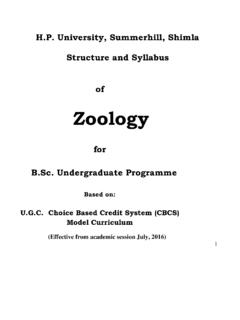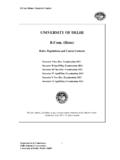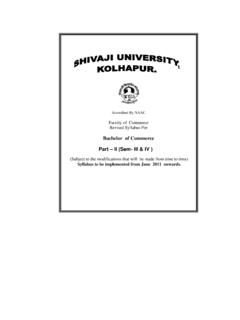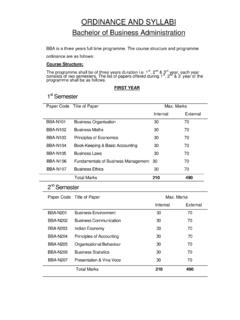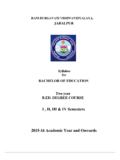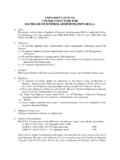Transcription of B. Com. : Three-Year (6-Semester) CBCS Programme
1 B. Com. : Three-Year (6- semester ) cbcs . Programme Basic Structure: Distribution of Courses 1 Ability-Enhancement 2 Papers of 4 Credit Hrs. each (Total 8. Compulsory Course (AECC) Credit Hrs. 4X2). 2 Skill-Enhancement Elective 4 Papers of 4 Credit Hrs. each (Total 16. Course (SEC) Credit Hrs. 4X4). 3 Core Course 12 Papers of 6 Credit Hrs. each (Total 72. Credit Hrs. 12X6). (5 Lectures and 1 Tutorial). 4 Discipline Specific Elective 4 Papers of 6 Credit Hrs. each (Total 24. (DSE) Credit Hrs. 3X6). (5 Lectures and 1 Tutorial). 5 Generic Elective (GE) 2 Papers of 6 Credit Hrs. each (Total 12. Credit Hrs. 3X6). (5 Lectures and 1 Tutorial). Total Credit Hours 132. Notes: 1 Ideal Lecture Class size: 50 to 60 students 2 Ideal Tutorial group Size: 12 to 15 students 3 Ideal Laboratory Practical Batch Size: 20 Students 1.
2 B. Com. : Three-Year (6- semester ) cbcs . Programme Structure Course Course Title Course Type No. semester I. BC Environmental Studies Ability-Enhancement Compulsory Course (AECC)-1. BC Financial Accounting Core Course C-1. BC Business Organisation and Management Core Course C-2. ENGL English 1 Core English (Compulsory for Core Course C-3. 101 ). semester II. BC Language: English/Hindi/Modern Indian Ability-Enhancement Language Compulsory Course (AECC)-2. BC Business Law Core Course C-4. BC Business Mathematics and Statistics Core Course C-5. HIND200 Hindi / Modern Indian Language Core Course C-6. semester III. BC Company Law Core Course C-7. BC Income Tax Law and Practice Core Course C-8. ENGL- English-II (Core English- Compulsory for Core Course C-9. 301 ). BC Computer Applications in Business Skill-Enhancement Elective Course (SEC)-1.
3 semester IV. HIND Hindi Core CourseC-10. 400. BC Corporate Accounting Core Course C-11. BC Cost Accounting Core Course C-12. BC E-Commerce Skill-Enhancement Elective Course (SEC)-2. semester V. BC Any one of the following Discipline Specific Elective (DSE)-1. a. Human Resource Management b. Principles of Marketing c. Auditing and Corporate Governance BC Any one of the following Discipline-Specific Elective (DSE)-2. a. Fundamentals of Financial Management b. Indirect Tax Law BC Entrepreneurship Skill-Enhancement Elective Course (SEC)-3. 2. BC Principles of Micro Economics Generic Elective (GE)-1. semester VI. BC Any one of the following Discipline- Specific Elective (DSE)-3. a. Corporate Tax Planning b. Banking and Insurance c. Management Accounting d. Computerised Accounting System BC Any one of the following Discipline- Specific Elective (DSE)-4.
4 A. International Business b. Office Management and Secretarial Practice c. Fundamentals of Investment d. Consumer Protection BC Personal Selling and Salesmanship Skill-Enhancement Elective Course (SEC)-4. Indian Economy Generic Elective (GE)-2. Note: 1. For Practical Lab based papers: a. Core Course papers BC (Financial Accounting) and BC (Income-tax law and Practice), there shall be 4 Credit Hrs. for Lectures + one credit hr. (Two Practical Periods per week per batch) for Practical Lab + one credit Hr for Tutorials (per group). b. Discipline Specific Elective paper (d) (Computerised Accounting System), there shall be 4 Credit Hrs. for Lectures + Two Credit hrs. (4 Practical Periods per week per batch). for Practical Lab c. Skill Enhancement Elective Course SEC-2 paper BC (E-Commerce), there shall be 3. Credit Hrs.
5 For Lectures + One Credit hrs. (2 Practical Periods per week per batch) for Practical Lab d. Skill Enhancement Elective Course SEC-2 paper BC (Computer Applications in Business), there shall be 2 Credit Hrs. for Lectures + Two Credit hrs. (4 Practical Periods per week per batch) for Practical Lab 2. For other core and elective papers, there shall be Five lectures and One Tutorial (per batch). 3. : semester I. Ability-Enhancement Compulsory Course (AECC)-1. BC : Environmental Studies Common Syllabus to be provided by the respective Department : semester I. Paper BC : FINANCIAL ACCOUNTING. Duration: 3 hrs. Marks: 50 Lectures: 52, Practical: 26. Objectives: The objective of this paper is to help students to acquire conceptual knowledge of the financial accounting and to impart skills for recording various kinds of business transactions.
6 CONTENTS. UNIT TOPIC DETAILS. 1 (a). Theoretical i. Accounting as an information system, the users of financial Framework accounting information and their needs. Qualitative characteristics of accounting, information. Functions, advantages and limitations of accounting. Branches of accounting. Bases of accounting; cash basis and accrual basis. ii. The nature of financial accounting principles Basic concepts and conventions: entity, money measurement, going concern, cost, realization, accruals, periodicity, consistency, prudence (conservatism), materiality and full disclosures. iii. Financial accounting standards: Concept, benefits, procedure for issuing accounting standards in India. Salient features of First- Time Adoption of Indian Accounting Standard (Ind-AS) 101. International Financial Reporting Standards (IFRS): - Need and procedures.
7 (b). Accounting From recording of a business transaction to preparation of trial Process balance. 2 (a). Business Income i. Measurement of business income-Net income: the accounting period, the continuity doctrine and matching concept. Objectives of measurement. 4. ii. Revenue recognition: Recognition of expenses. iii. The nature of depreciation. The accounting concept of depreciation. Factors in the measurement of depreciation. Methods of computing depreciation: straight line method and diminishing balance method; Disposal of depreciable assets-change of method. iv. Inventories: Meaning. Significance of inventory valuation. Inventory Record Systems: periodic and perpetual. Methods: FIFO, LIFO and Weighted Average. Salient features of Indian Accounting Standard (IND-AS): 2 (Theory only). (b). Final Accounts Capital and revenue expenditures and receipts: general introduction only.
8 Preparation of financial statements of non-corporate business entities 3 Accounting for Hire- i) Accounting for Hire-Purchase Transactions, Journal entries and Purchase and ledger accounts in the books of Hire Vendors and Hire purchaser for Installment Systems, large value items including Default and repossession. Consignment, and ii) Consignment: Features, Accounting treatment in the books of the Joint Venture consignor and consignee. iii) Joint Venture: Accounting procedures: Joint Bank Account, Records Maintained by Coventurer of (a) all transactions (b) only his own transactions. (Memorandum joint venture account). 4 Accounting for Inland Accounting for Inland Branches Branches and Concept of dependent branches; accounting aspects; debtors system, Accounting for stock and debtors system, branch final accounts system and whole Dissolution of sale basis system.
9 Independent branches: concept accounting Partnership Firm treatment: important adjustment entries and preparation of consolidated profit and loss account and balance sheet. Accounting for Dissolution of Partnership Firm Accounting of Dissolution of the Partnership Firm Including Insolvency of partners, sale to a limited company and piecemeal distribution Practical Computerised Computerised Accounting Systems: Computerized Accounts by using Accounting Systems any popular accounting software: Creating a Company; Configure and Features settings; Creating Accounting Ledgers and Groups; Creating Stock Items and Groups; Vouchers Entry; Generating Reports Cash Book, Ledger Accounts, Trial Balance, Profit and Loss Account, Balance Sheet, Funds Flow Statement, Cash Flow Statement Selecting and shutting a Company; Backup and Restore data of a Company Note: 1.
10 The relevant Indian Accounting Standards in line with the IFRS for all the above topics should be covered. 2. Any revision of relevant Indian Accounting Standard would become applicable immediately. 3. Examination Scheme for Computerised Accounts Practical for 20 marks. The practical examination will be for 1 hour. 5. 4. Theory Exam shall carry 50 marks 5. Marks for CCA (Continuous Comprehensive Assessment) shall be 30 marks Suggested Readings: 1. Robert N Anthony, David Hawkins, Kenneth A. Merchant, Accounting: Text and Cases. McGraw- Hill Education, 13th Ed. 2013. 2. Charles T. Horngren and Donna Philbrick, Introduction to Financial Accounting, Pearson Education. 3. Monga, Financial Accounting: Concepts and Applications. Mayur Paper Backs, New Delhi. 4. , Grewal and Advanced Accounts. S. Chand & Co., New Delhi.

